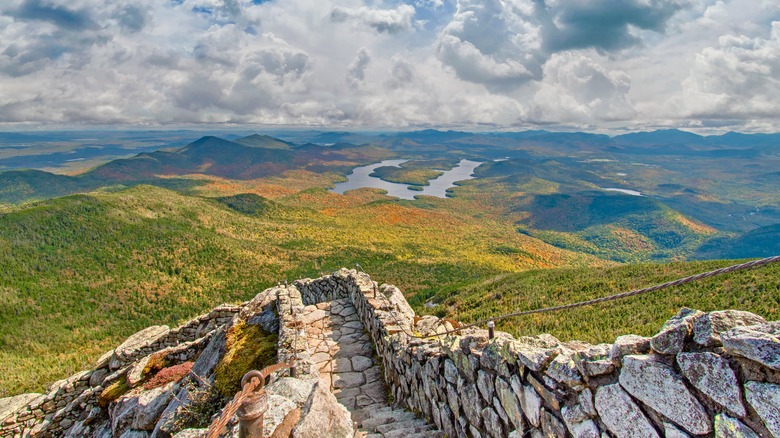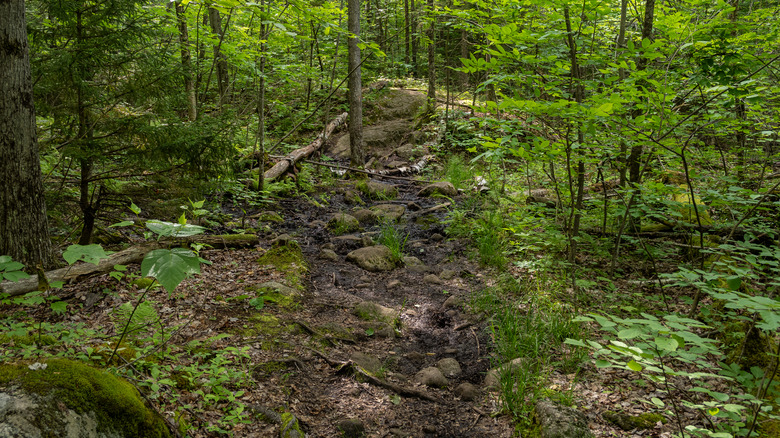The Best Ways To Prepare For Hiking During The Adirondack Mountains' Muddy Season
Every year, snow gets dumped on the Adirondack Mountains in upstate New York. Snow cloaks the mountains starting in October and peaks in December through February at a rate of up to 10 inches a day, and sometimes that snow doesn't stop until early May. That snow melts in spring and transforms the soil into soup. Folks who've trekked through the 6 million-acre Adirondack Park know how dangerous this can be — and how difficult it can be, too, before the sun cooks the ground and dries everything up in time for summer. So if you're thinking of hitting the trails right about mid-May, you'd best be prepared.
Gear and supply choices for tackling the Adirondacks in the mud season are pretty common sense. They boil down to two rules: Bring everything, and plan for the worst. You want to carry some of the same stuff you'd carry at any time of the year, like water, food, bug spray, good hiking boots, extra socks, and a compass and flashlight for safety. But to counter the mud and patches of still-melting snow, you should also wear warm wool socks and consider packing snowshoes, waterproof boots, waterproof matches, and a lighter. Assume that you might get stuck outside in some nasty weather. Read some trail guides for the hikes you're planning to undertake, and plan accordingly. Spring in the Adirondacks can be mercurial and flip from sunny to rainy to windy on a dime. Don't make the newbie mistake of assuming that you're going to be waltzing through pristine, sunlit trails with a perpetual smile on your face. It's best to keep a close eye on weather via the National Weather Service.
Hiking your way through the best trail choices
Choosing the best gear and supplies for the Adirondacks is one thing, but choosing the right trails is another matter entirely. This isn't an easy task considering the vastness of the Adirondacks and their various regions. So in general, it's smart to err on the conservative side of trail choices. Rather than embark along a challenging but satisfying trek up Mt. Marcy, for instance, stick to lower elevations – no more than 3,000 feet above sea level is best. A short, 2.2-mile hike up Mount Arab is therefore a good choice, even for kids. You could also try the popular and pretty Bald Mountain-Rondaxe trail, which caps at around 2,350 feet above sea level.
If you really want a more challenging option, you could go for something like Cascade Mountain, which as an elevation of almost 4,100 feet and an elevation gain of 1,940 feet, but has flat patches to balance things out along the 2.4-mile path to its summit. In the wintertime, this trail requires snowshoes and either crampons or spikes on your boots. If the snow hasn't melted, things are going to get tough. And don't underestimate the wetness. Some trails aren't merely muddy — they're practically bogs where the water will easily soak through sneakers. Check the New York Department of Environmental Conservation website for up-to-date info about trail conditions.
However you hike, remember that trail integrity is critical to the whole springtime hiking venture. Trust your waterproof boots, and walk right through watery, muddy patches rather than around. Otherwise, you run the risk of ruining the trail borders and making the path an even worse muddy mess for everyone else. Also remember to be wary of bodies of water; frozen lakes in the Adirondacks might not be as solid as they appear.

